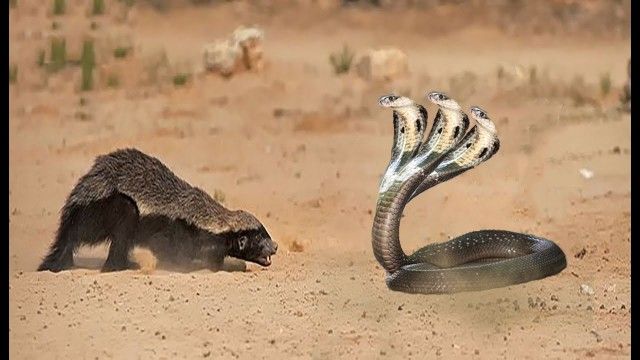Honey Badger
What Is A Honey-Badger?
The honey badger is a member of the Mellivora family, in the sub-family “Mustelid”. The honey badger is related to the American Badger, the European Badger, the Asian Badger, the Japanese Badger, the Chinese Ferret Badger, the Burmese Ferret Badger, the Javan Ferret Badger, and the Bornean Ferret Badger. It is also closely related to members of the Martin family, and less so to weasels and Polecats. A common misconception is that, due to their behavior, they are related to wolverines. This is only partially true, they are only distantly related to wolverines. Honey badgers are a type of badger, which are known for their abilities to burrow and their long claws.
What Does A Honey Badger Look Like?
Honey badgers are distinct from other badgers due to their sleek, two color design. From a distance, one can mistake the white stripe and black markings for a common skunk. Upon closer observation, it can be noted that the front claws are extremely long, and that the neck is long and pushed forward. The tail, although it does store similar vile liquid to a skunk, is much shorter and does not perk upwards, rather it hangs loose to the ground. The face of the honey badger is also very different from a skunk as it presents large cheekbones with a narrow, short snout. It also has a series of many very sharp teeth which can be observed as it clamps down on your legs. Honey badgers are roughly the size of a housecat, so they are smaller than European Badgers. 
Ratel:
The honey badger got the name “ratel” or “rattle” in Dutch/Afrikaans due to it’s unique and extremely aversive sound. The sound, which is every distinct, sounds like a loud-pitched rattle. Additionally, there is a speculation that honey badgers eat cobras frequently, due to being immune to their poison. Because cobras produce a rattle, it is rumored that the name “rattle” was given for its habit of eating cobras.
Honey Badger Diet:
Honey badgers are omnivores. They will scavenge for roots, berries, and whatever else they can get their claws on. Honey badgers are also ferocious hunters. They are known to hunt insects, fish, small to medium sized mammals, birds, and snakes. Honey badger diets are often the result of the environment they are born into. Because they cover a vast area on multiple continents, there is no honey badger pure staple diet known to humans.
Honey Badger Don’t Care:
This honey badger don’t care:
Honey Badger V.S. Lion Video:
In a rare video caught on tape, a group of honey badgers were caught beating, biting, scratching, and generally fighting a pride of lions. It turns out that the honey badgers win the engagement.
Honey Badger V.S. Snake:
As mentioned earlier, one of the alleged “staple” foods of the honey badger are snakes. Particularly, cobras. Honey badgers are immune to cobra venom. They are great for wiping out entire gene pools of snakes in an area. Check out this video:
Where Do Honey Badgers Live?
Honey badgers live in almost every country in continental Africa. Only parts of North Africa to the fertile crescent are spared from the honey badger’s presence. They are somehow found in India and Saudi Arabia. Proliferation of the species is anticipated to create new colonies further than the map below. They have few natural predators and are usually only stopped by large deserts and human activity.

Honey Badgers For Sale:
Honey badgers are illegal for sale and distribution in most countries in the world. Although it is possible to buy them on the black market or with special permits, it is highly discouraged. Like humans, honey badgers are known to engage in the killing of more food than necessary to survive, the hoarding it. This is known as “surplus killing”. This would make it very dangerous to have a honey badger as a pet, especially around other pets and children. It has been additionally dually noted that multiple occasions of human fatalities inflicted by honey badgers are confirmed by credible sources. This should discourage anyone that is in the “black market” for a honey badger.
Honey Badgers Lethal:
In an incident in Botswana, it was recorded that a man was killed and eaten by a honey badger. A single honey badger pounced on the man, squirted him with vile fluids and ate him. Evidence shows that baby honey badgers then joined in on the feast and ate the man almost completely prior to being found. Police were notified and “hit teams” from the Botswanan armed forces dispatched all the honey badgers in the area, fearing that they now craved human flesh. So yes, as far as it can be foretold, honey badgers are lethal to humans.
Additionally, there are documented cases of bacterial infections and Ebola from honey badger bites and honey badger bush meat. These are also extremely fatal to humans. Do not even try to pet or eat feral honey badgers. You have been warned!
How Did The Honey Badger Get Its Name?
The honey badger is obviously a slang terminology for “Ratel”. The name was awarded to the honey badger after wildlife researchers observed the honey badger attacking bee nests, ignoring stings, and eating the honey combs and honeybee larvae. The honey badger’s known favorite treats are honey covered bee larvae. Due to the honey badger’s thick skin, it is immune to the stings. And much like snake venom, even African bee venom does not affect the ratel. Some say the tongue of a honey badger even works and looks like a honey spoon.
When you subscribe to the blog, we will send you an e-mail when there are new updates on the site so you wouldn't miss them.
